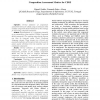96 search results - page 7 / 20 » The role of secondary attributes in formal object modelling |
106
click to vote
RSKT
2007
Springer
15 years 5 months ago
2007
Springer
Abstract. A fundamental data modeling problem in geographical information systems and spatial database systems refers to an appropriate treatment of the vagueness or indeterminacy ...
136
click to vote
LPAR
1999
Springer
15 years 3 months ago
1999
Springer
Abstract. Description Logics (DLs) are a family of knowledge representation formalisms mainly characterised by constructors to build complex concepts and roles from atomic ones. Ex...
104
click to vote
SIGMOD
2000
ACM
15 years 4 months ago
2000
ACM
We consider spatio-temporal databases supporting spatial objects with continuously changing position and extent, termed moving objects databases. We formally define a data model f...
85
Voted
EUROMICRO
2005
IEEE
15 years 5 months ago
2005
IEEE
Objective: Formal definition of composition assessment metrics for CBSE, using an extension of the CORBA Component Model metamodel as the ontology for describing component assembl...
CAISE
2004
Springer
15 years 5 months ago
2004
Springer
: While some information modeling approaches (e.g. the Relational Model, and Object-Role Modeling) are typically formalized using first-order logic, other approaches to information...

